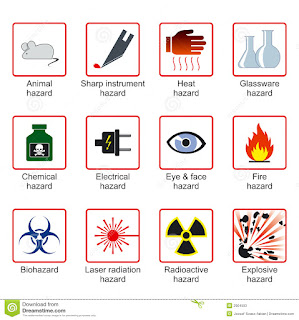Obviously working in a lab can be very dangerous, that is why it is important to have standards set in laboratories so that the people working in them know what is safe and what is not safe. OSHA has a standard for laboratory safety to make sure that people are being safe while working. But what does the OSHA Standard include? Well, according to the Standard, found in 29 CFR 1910.1450, the main components are Monitoring/PELs, Information and Trainings, Medical Consultation, Hazard Identification, Recordkeeping and Respiratory Protection. What is a PEL? A PEL is the permissible exposure limit. So, the monitoring/PEL section in the standard is all about discussing how you monitor chemicals/fumes and how much exposure someone can have to a substance. In the Information and Training section contains the Hazard Communication, or HazCom which describes hazards that can happen in the lab when dealing with certain substances. It is important to look at the HazCom when dealing with a new substance, because if you haven't worked with it before you may be unaware of possible hazardous exposures. This section also tells information about the signs of possible symptoms if an exposure ever occurs. This is important when talking about different chemicals because different chemicals may lead to different symptoms. Also, how to use personal protective equipment is described in this section as well as how to recognize hazards in the lab. Medical consultation occurs whenever there are signs of symptoms, as well as if the monitoring shows that the exposure limit has been exceeded. This also happens if there is an accident in the lab, such as a spill. No matter what the accident may be, there will be medical consultation afterwards because of the possibility of an exposure that could be hazardous to the employees health. Getting medical treatment does not cost the employee anything. Labels need to be easily read for hazard identification purposes. This is a very important area of this standard. If there are chemicals that are not properly labeled in the lab, someone working might think they are using a chemical that is not as toxic as what they are really using, or they might be mixing chemicals together and thinking they are using a different chemical, mix it with another and cause exposures that could be very dangerous to ones health. Respiratory protection will not cost the employee anything. Recordkeeping is done for many things in the lab and has to be done for every employee. This includes medical records and records concerning exposures as well. These medical records are kept for 30 years after an employee works in a lab. Why you may ask? Well, if someone was working in a lab years ago and become sick years later after they worked there, the records to what they possibly could have been exposed to will be very helpful with the medical knowledge of the former employee. Those are the main components of the OSHA Lab Standard. I hope this blog was helpful in providing information about this topic.


No comments:
Post a Comment